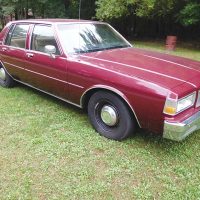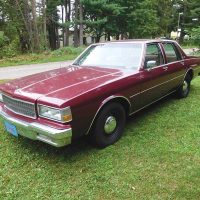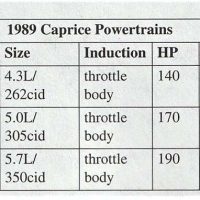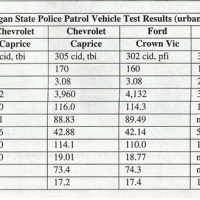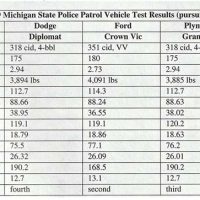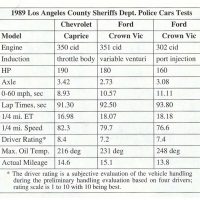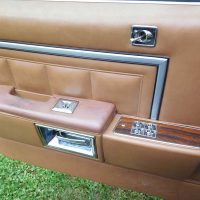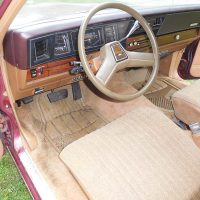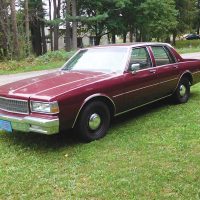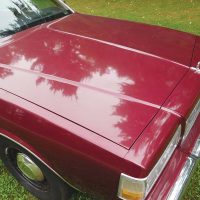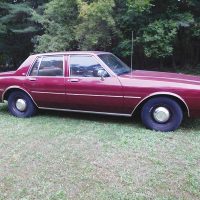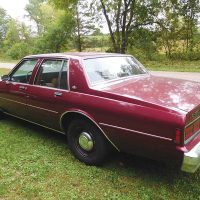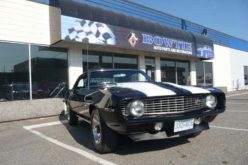By John Gunnell
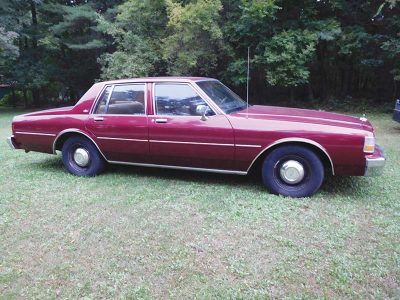
Front bumper has no bumper guards.
Chevrolet’s 9C1 package was a Special Equipment Option (SEO) for law enforcement—and now muscle car fans. The various 9C1 packages included modifications and upgrades of different sizes and types of Chevrolets from full-sized sedans, to Camaros to SUVs. Each 9C1 option package was unique and diverse, with choices within the package, but they all added increased build quality, durability and performance to a standard Chevrolet, as well as required law enforcement lighting and equipment.
Heavy-duty features of the full-size 9C1s included a steel, full-perimeter frame; bigger brakes; a heftier suspension; larger and wider speed-rated tires; a high-output alternator; heavy-duty steel wheels and speed-rated tires; quick-ratio power steering; transmission and power steering oil coolers; a certified speedometer; added and stiffer body mounts; dual exhausts; added electrical wiring and special engines. Automotive historian Matt Joseph once opined about the 9C1, “If General Motors had built its civilian cars like this years ago, we wouldn’t be driving Japanese cars today.”
In the ‘70s and ‘80s, Chevrolet offered factory-produced 9C1 versions of the Nova, Malibu, Celebrity, Impala, Caprice and Lumina. Starting in 1986, the Caprice (not Caprice Classic) replaced the Impala for the retail, taxi and police markets. “Cop car” versions were based on the third-generation model launched in 1977. Like its civilian counterparts, the 9C1 would get a facelift in 1987 and remain much the same until 1990. Our featured car is a 1989 Caprice 9C1, which has a couple of features that make it very popular.
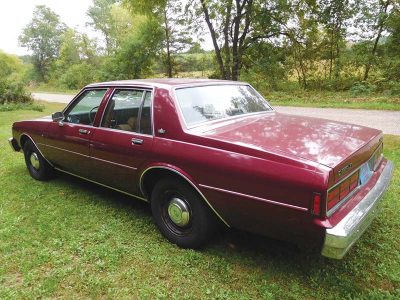
Chevy 9C1s were Caprices rather than Caprice Classics.
In 1989, the 9C1 was switched from a traditional four-barrel carburetor to fuel injection. This made it a more reliable, better-performing police car. Despite this upgrade, the 1989 model retained the seat and shoulder belt system used in 1988 with the shoulder belts attached to the seat itself. In 1990, fuel injection was featured again, but the seat belt/shoulder belt anchors were moved to the doors. This was unpopular with law enforcement officers because they could get tangled up in the belts while exiting.
The 1989 Caprice in the photos was in service with the Wisconsin State Patrol. It was a supervisor’s car, which meant it was painted burgundy instead of dark blue. Supervisor cars were unmarked. They usually had the full police package, except for push bumpers and a prisoner “cage” between the front and rear seats.
Due to their popularity, the ‘89 Chevy 9C1s sold like crazy. According to Ed Sanow’s book Chevrolet Police Cars (1997, Krause Publications) they were used by “the California Highway Patrol, Michigan State Police and nearly every department in between.” Chrysler left the police car business that year and most of it went to Chevy.
For around-town cruising, local police departments could get a 1989 9C1 with a 305-cid 170-hp V8, but the hotter engine choice was Chevy’s new L05 350-cid V8 with throttle-body fuel-injection. It made 190 hp thanks to the improved induction setup and a higher 9.3:1 compression ratio. Also new was a 3.42:1 rear axle replacing a 3.08 rear.
In Michigan State Police tests, the 1989 Caprice 9C1 did the quarter mile in 17.6 sec. at 79.8 mph, which compared to 18 sec. at 78 mph in 1988. Even more impressive was a 29.3 sec. 0-100 time versus 34.9 sec. for 1988 models. The carbureted Caprice required 1.25 miles to hit 110 mph, while the injected 9C1 did it in just .95 mile. Out in Los Angeles, another quarter-mile test had the Caprice 9C1 doing the distance in 16.98 sec.
Inside, the 9C1 featured police-car-only front bucket seats (in a four-door sedan), an under-dash gauge package and a “ticket light” (extra round courtesy lamp positioned for good ticket writing). The courtesy lights did not go on when the doors were opened, since that would illuminate the officers inside when they got to a potential crime scene.

This car has had one repaint in original colour.
Some police agencies ordered their 9C1s with full-size spare tires. In other locales, including Wisconsin, no spare tire was carried. If a police car suffered a flat, the officer would call in and a brand-new speed-rated tire would be delivered. Damaged tires were not repaired. A sticker in the trunk listed all of the options the police cars originally came with. However, many agencies had their own mechanics servicing the cars and tearing them down for repairs, so parts swapping with worn out or wrecked 9C1s was common. As a result, many cars wound up with equipment not originally ordered for them.
Most police and highway patrol departments kept police cars in service for a certain number of years and/or a certain number of miles. Since supervisor cars usually saw fewer miles of use, they were kept in service for a longer time, but did not normally get exposed to the rough use the regular police cars saw. The car in the photos was well maintained all its life and was retired from law enforcement service at 100,000 miles.
The collector who owns this Caprice had purchased a regular blue 1989 Wisconsin State Patrol “box car” (the nickname for all square Caprices) for his son. That car had had a push bumper and cage that the seller marketed separately. The blue car had ignition upgrades and other engine modifications because it was being drag raced at Wisconsin International Raceway in Kaukauna, Wis. Even though it had passed 200,000 miles on its odometer, driving the blue 9C1 was very similar to driving a ‘60s muscle car.
Once he had been behind the wheel of his son’s car, the man wanted his own 1989 Caprice 9C1. He was told about a man who was trying to sell one in the Car Corral at the Fall Jefferson (Wis.) swap meet (www.madsionclassics.com). A call to the swap meet organizers helped him get a phone number and he went to see the burgundy car. The seller actually had another burgundy car and a blue one, but they were not as nice as this car. After a little bargaining, the man made his offer and the seller said, “I’ll have to go talk to my wife about that.” As soon as the buyer heard that, he knew he had a deal!
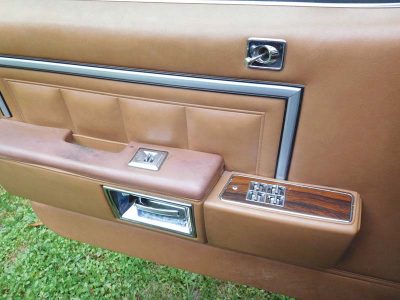
This 9C1 has power windows and power door locks.
The Caprice has been used very little, other than one trip to Florida awhile back. After that it was treated to new brakes and a complete new exhaust system. The only much nicer ’89 Box Car the owner has seen for sale online was a California airport security car that was white and had low mileage because it had hardly ever left the airport. Caprice 9C1s with 5.0-litre (305) V8s were also used by fire departments and taxi drivers.
But sales of the 350-cid models were more restricted. “It is General Motors policy that the Chevrolet Caprice Police Package Equipped with the 5.7-litre V8 be sold only for usage by U.S. state or local government, primarily for police, law enforcement or fire-fighting services,” said GM’s 1989 Corporate Average Fuel Economy (CAFÉ) statement.
The police liked that idea. They didn’t want crooks getting their hands on 9C1s with the “Corvette” engine. But muscle car enthusiasts are scooping the cars up today.





